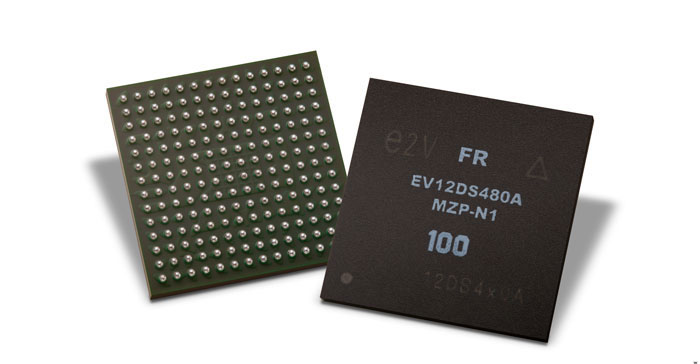Digital-to-analog converter (DAC) technology is one specialty of Teledyne e2v, which has been developing such converter solutions for many years. The company recently announced its latest DAC, which it says can achieve clean signal generation at frequencies as high as 26.5 GHz.
The recently unveiled DAC, the EV12DS480, is a 12-b DAC with a sampling rate of 8 Gsamples/s. Kurt Rentel, business development manager of signal processing solutions at Teledyne e2v, recently explained the new product in more detail.
The EV12DS480 achieves a sampling rate of 8 G samples/s and can be used in systems that operate all the way into Ka-band frequencies.
“Teledyne has been developing really broadband data converters for a long time,” said Rentel. “On the D/A side, that means direct launching into some RF band. Original converters developed probably over 20 years ago were in the L-band range. Our new DAC has a sampling rate of up to 8 Gsamples/s, and it also has 8 GHz of analog bandwidth.”
Rentel is quick to point out that the EV12DS480 is still usable beyond 8 GHz. “It rolls off after 8 GHz—but it’s a single pole roll-off and it’s got a sin(x)/x roll-off as well,” he explained. “That allows our customers to actually use it above its 3-dB bandwidth. It’s being used at 10 GHz; some people are considering it at X-band; some people are looking at using it up into Ku- and Ka-band because it still has reasonable power and it really simplifies systems—you have digital bits going in one end and RF out the other.”
According to Rentel, system simplification is a major advantage that the EV12DS480 brings to the table. “The simplified-system aspect of this is that you get rid of analog upconversion stages with the DAC. If you look at a block diagram, the EV12DS480 takes a chunk away from it. This DAC takes away a mixer and a synthesizer that had to drive that mixer and replaces them with their digital equivalents. That happens in a FPGA or some type of processing unit that sits in front of the DAC.”
So what applications are being targeted? “As a business unit, we focus a lot on high-reliability, high-performance, long-life systems,” added Rentel. “Avionics and space applications fall into that category. This product is designed and specified to be used in high-reliability applications like aircraft systems and space. If you want long life and very reliable operation, you need to have high-reliability components. We start by saying that we want these products to work for these high-reliability applications—and then we will certainly move into less stringent areas like instrumentation and some of the communications systems.”



















